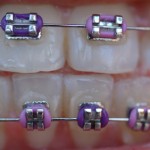
Orthodontic brackets are commonly attached using a direct bonding technique. Indirect bonding where brackets are located on a model in a laboratory stage before being place with the help of a tray during a clinical stage was proposed to improve the accuracy of bracket positioning. However there is still uncertainty as to whether it does lead to better positioning and treatment outcomes.
The aim of this review was to compare the effectiveness (bracket placement accuracy), efficiency (total working time and chairside time) and adverse effects (oral hygiene status and bond failure rate) of direct and indirect bonding techniques in orthodontic patients.
Methods
Searches were conducted in the Medline/PubMed, Embase, Central, Web of Science Clinicaltrial.gov, OpenGrey and the World Health Organization’s International Clinical Trial Registry Platforms with no language restrictions. Randomised controlled trials (RCTs) in patients undergoing orthodontic treatment comparing direct and indirect orthodontic bonding techniques were considered. The main outcomes were bracket placement accuracy, total working time, chairside time, oral hygiene status, bond failure rate. Two reviewers independently screened and selected studies, extracted data and assessed risk of bias using the Cochrane tool. Risk ratios (RR) and 95% confidence intervals were calculated for dichotomous data and random effects meta-analysis conducted.
Results
- 8 RCTs (6 split-mouth studies) involving a total of 247 patients were included.
- All 8 studies were at unclear risk of bias.
- Bracket placement accuracy
- 2 RCTs found no significant difference with 1 other trial demonstrating smaller errors for indirect bonding and another trial finding superiority with direct bonding.
- Treatment efficiency
- 3 RCTs consider this outcome with all 3 finding that indirect bonding required significantly longer total working time and shorter clinical chairside time compared with the direct bonding.
- Oral Hygiene status
- 3 RCTs consider this outcome with 2 studies showing no significant difference and 1 showing less plaque accumulation in the indirect group.
- Bond failure rate
- Meta-analysis (5 RCTs) showed no difference between direct and indirect bonding; RR= 1.13 (95%CI; 0.78 -1.64).
Conclusions
The authors concluded: –
Within the limitation of this systematic review, clinical evidence suggested that the direct and indirect bonding techniques had no significant difference in bracket placement accuracy, oral hygiene status and bond failure rate for bonding non-customized labial/buccal orthodontic brackets. The indirect bonding might require less chairside time but more total working time in comparison with the direct bonding technique. High-quality and well-designed randomized controlled trials are needed in order to make a conclusive recommendation.
Comments
While a number of databases have been searched and no language restrictions were placed only a small number of small studies could be identified. None of the included studies were of low risk of bias largely due to difficulties with blinding of the patients and study personnel but also due to uncertainty regarding allocation concealment. In addition to the small size of the studies only 3 of those included were longer than 12 months duration with 2 not specifying a duration and one being of 6 months duration. As the authors suggest well conducted and reported studies of appropriate size and duration are needed. It is also worth noting that the 2018 Cochrane review (Dental Elf – 24th May 2018) only identified 3 studies when trying to evaluate difference orthodontic adhesives for bonding.
Links
Primary Paper
Li Y, Mei L, Wei J, Yan X, Zhang X, Zheng W, Li Y. Effectiveness, efficiency and adverse effects of using direct or indirect bonding technique in orthodontic patients: a systematic review and meta-analysis. BMC Oral Health. 2019 Jul8;19(1):137. doi: 10.1186/s12903-019-0831-4. PubMed PMID: 31286897.
Other references
Dental Elf – 24th May 2018
